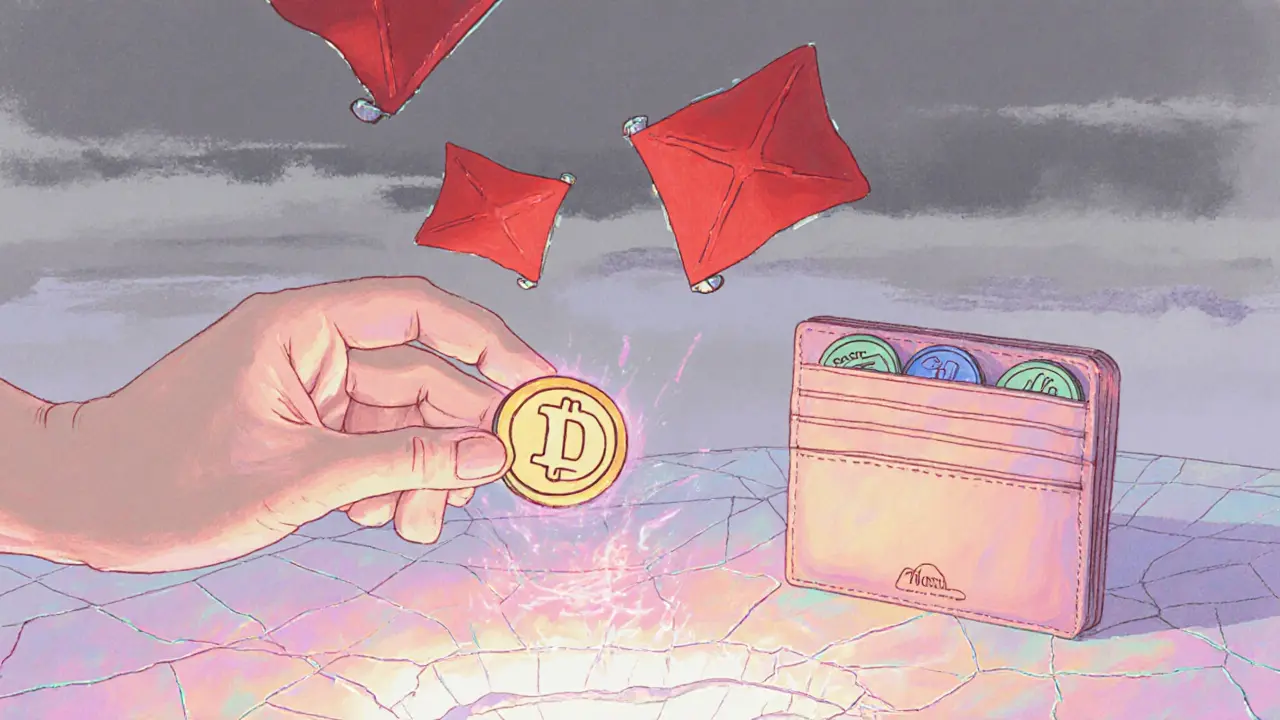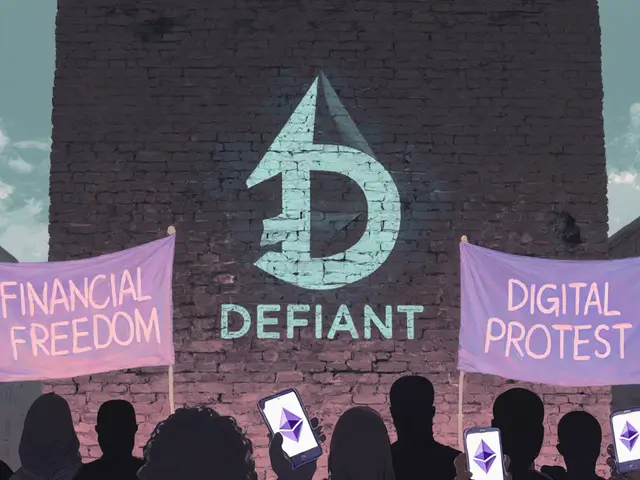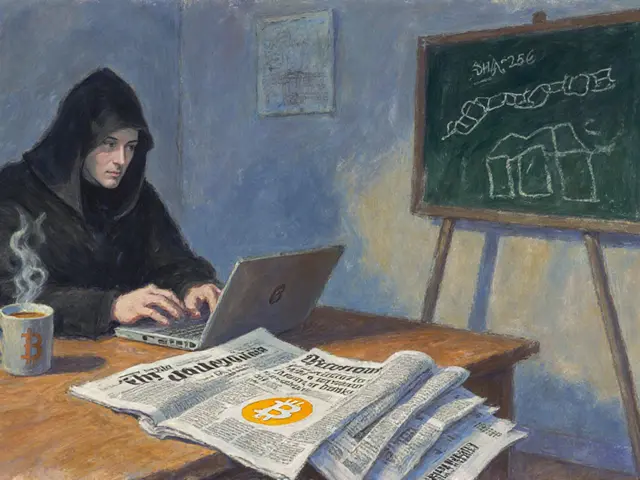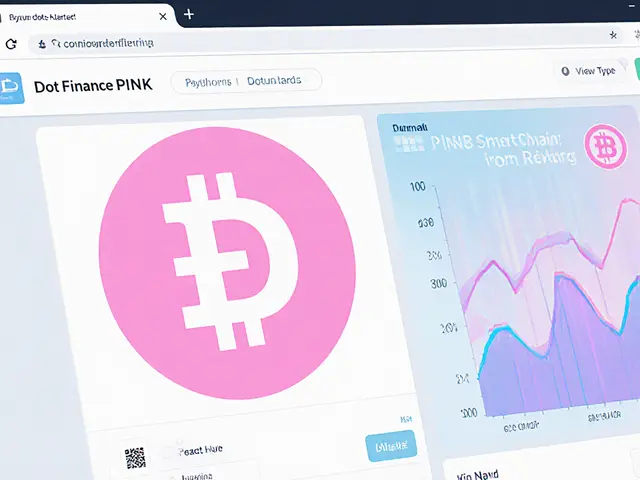Defiant (DEFIANT) Crypto Coin Explained: History, Price, Risks & How It Stacks Up

Micro-Cap Crypto Risk Calculator
Investment Risk Calculator
Calculate potential outcomes based on the extreme volatility and liquidity risks of micro-cap coins like Defiant (DEFIANT).
Potential Outcome
Comparison to Established Coins
| Feature | Defiant (DEFIANT) | Dogecoin (DOGE) | Shiba Inu (SHIB) |
|---|---|---|---|
| Market Cap | $55k | $14.2B | $9.8B |
| 24h Volume | $360 | $3.1B | $800M |
| Community Size | 2-3 mentions/day | 45k mentions/day | 30k mentions/day |
| Price Volatility | Extreme (99.85% drop) | Low | Low |
When you hear the name Defiant crypto, you might picture a rebellious meme coin that promises financial freedom. The reality is a lot less glamorous - a tiny token with barely any trading volume, wild price swings, and more questions than answers. This guide pulls together the most reliable data up to October 2025, breaks down what Defiant actually is, shows how it compares to well‑known meme coins, and highlights the red flags you should watch before even thinking about buying.
What Defiant (DEFIANT) Actually Is
Defiant (DEFIANT) is described by its own documentation as a “counter‑culture cryptocurrency born from digital protest.” It markets itself as more than a meme coin, claiming to empower users with financial freedom, transparency, and security. In practice, Defiant is an ERC‑20 token - a smart‑contract asset that lives on the Ethereum blockchain. It is not mineable, has no pre‑mined reserve, and the official sources do not publish a whitepaper or detailed roadmap.
Key stats (October 2025):
- Total supply: 1 billion tokens
- Circulating supply: reported inconsistently - between 0 and 1 billion
- Market cap: roughly $55 k (sources differ slightly)
- Daily trading volume: under $400 on the few exchanges that list it
- All‑time high price: $0.023626 on 17 Apr 2025
- All‑time low price: $0.00003602 on 19 May 2025 (a 99.85 % collapse)
How Defiant Positions Itself
The token’s marketing narrative focuses on three use cases: interest‑earning, e‑commerce, and NFTs. None of these claims have been backed by concrete product releases or developer updates. The project’s presence on LBank - a mid‑tier exchange - is the only real “listing” most people see, and even there the liquidity is negligible.
Because there is no publicly audited code, no documented partnerships, and no active community (Reddit, Discord and Twitter chatter is virtually non‑existent), the stated goals look more like hype than a viable roadmap.
Price History - A Roller Coaster in Micro‑Cap Land
Defiant’s price chart is a textbook example of a pump‑and‑dump scenario. After a brief surge to $0.023626 in April 2025, the token fell to a low of $0.00003602 a month later. Since then, prices have hovered between $0.000055 and $0.000080, with each exchange showing slightly different numbers. The volatility is driven mostly by the tiny pool of traders; a single buy or sell order can move the price by multiple percentage points.
Even a modest 5 % monthly gain reported by some data sites means the token is still trading at less than a tenth of a cent - far from any realistic investment horizon.

Liquidity Problems - Why Buying Even Small Amounts Is Hard
With a 24‑hour volume under $400, the market is effectively illiquid. If you try to buy $1,000 worth of DEFIANT on the listed exchange, you’ll probably push the price up by 50 % or more, ending up paying a lot more per token than the quoted price. This kind of slippage makes it almost impossible to execute trades without losing a significant portion of your capital.
Low volume also means that exchanges can delist the token with minimal notice, leaving holders with coins they can’t move.
How Defiant Stacks Up Against Real Meme Coins
To put the token in perspective, here’s a quick side‑by‑side comparison with the two biggest meme coins that dominate any conversation about “fun” cryptocurrencies.
| Metric | Defiant (DEFIANT) | Dogecoin (DOGE) | Shiba Inu (SHIB) |
|---|---|---|---|
| Market Cap | ≈ $55 k | $14.2 B | $9.8 B |
| Launch Year | 2025 | 2013 | 2020 |
| Token Type | ERC‑20 | ERC‑20 (originally fork of Litecoin) | ERC‑20 |
| 24‑h Volume | ≈ $360 | $3.1 B | $800 M |
| Community Size (Twitter/X mentions per day) | 2‑3 (mostly bots) | ≈ 45 k | ≈ 30 k |
The numbers speak for themselves: Defiant is a micro‑cap token with negligible liquidity, while Dogecoin and Shiba Inu command billions in market cap and active communities. If you’re hunting for a meme‑coin with real ecosystem activity, Defiant simply doesn’t qualify.
Red Flags Every Potential Buyer Should Note
- Extreme price volatility - A 99.85 % drop in one month is a warning sign.
- Very low trading volume - Makes entry and exit expensive.
- Inconsistent data - Circulating supply and price differ across CoinMarketCap, CoinGecko, and Coincodex.
- Lack of documentation - No whitepaper, roadmap, or developer repository.
- Sparse community - Almost no Reddit or Discord activity, only a few automated tweets.
- No real utility - Interest‑earning, e‑commerce, and NFT claims are unproven.
Taken together, these factors push Defiant into the “high‑risk, low‑reward” category that most analysts label as likely to disappear within a year.

Should You Consider Holding Defiant?
If you’re looking for speculative upside, remember that any future price bump would require a massive influx of new buyers - something that has never happened for DEFIANT. The token’s limited presence on exchanges means you could be stuck with a coin you can’t sell. For most investors, the safer move is to stay away and focus on assets with proven liquidity, transparent teams, and active ecosystems.
That said, if you enjoy digging into obscure projects purely for research or for a tiny “collector’s” niche, you can keep a few tokens in a hardware wallet. Just treat them as a learning experiment, not as an investment.
How to Safely Interact With Defiant (If You Must)
- Use a reputable non‑custodial wallet that supports ERC‑20 tokens (e.g., MetaMask or Trust Wallet).
- Verify the contract address from a trusted source - there have been multiple copy‑cat scams.
- Only trade on an exchange that lists DEFIANT and displays real‑time order book depth (most large exchanges do not list it).
- Set strict stop‑loss limits; given the extreme slippage, a 20 % drop could wipe out your position instantly.
- Never invest money you can’t afford to lose - treat this as a high‑risk experiment.
Bottom Line - The Verdict on Defiant (DEFIANT)
Defiant markets itself as a rebellious, community‑driven token, but the data tells a different story. With a market cap under $60 k, daily volume in the low hundreds, and virtually no community, the token is more a curiosity than a viable cryptocurrency. The extreme price collapse, lack of documentation, and ambiguous supply figures make it a classic micro‑cap risk. Unless you have a very specific reason to hold a token that essentially sits on the edge of obscurity, the safest recommendation is to stay clear.
Is Defiant (DEFIANT) listed on major exchanges?
No. Defiant only appears on a few low‑liquidity platforms such as LBank and a handful of decentralized exchanges. It is not available on Binance, Coinbase, or Kraken.
What is the biggest risk of buying DEFIANT?
The primary risk is illiquidity - you may not be able to sell the token without causing a massive price drop, and the market could disappear entirely.
Does Defiant have any real use cases?
Officially it claims interest‑earning, e‑commerce, and NFT support, but no functional products or integrations have been released, so there are no proven use cases.
How does Defiant compare to Dogecoin?
Dogecoin has a market cap in the billions, daily volume in the billions, and a vibrant community. Defiant sits at a few tens of thousands in market cap, under $400 daily volume, and almost no community - a stark contrast.
Can I store DEFIANT in a hardware wallet?
Yes. Because it’s an ERC‑20 token, any hardware wallet that supports Ethereum (e.g., Ledger, Trezor) can store DEFIANT safely.







Wow, this coin sounds like a total circus.
When you peer beneath the glossy veneer of a token marketed as “counter‑culture,” you often find a mirror reflecting the same power dynamics it claims to reject. Illiquid micro‑caps like DEFIANT become perfect tools for the elite to siphon capital under the guise of rebellion. The absence of a whitepaper or transparent roadmap is not just negligence; it’s a deliberate veil. Remember, every time a token spikes then crashes, it reinforces the narrative that only the informed few survive. If you doubt the motives behind such projects, you’re not alone.
Stop ignoring the glaring red flags and start doing basic due‑diligence. The token’s volume is under $400 a day-hardly a market, more like a dust bowl. No audited code, no real partnerships, just hype on a ghost website. Anyone buying this is basically handing over cash to anonymous whales. Wake up, the only thing it’s stacking up is your risk.
While I appreciate the author’s thorough compilation of data, I must underscore the importance of community engagement as a metric of sustainability. A token that registers merely two to three mentions per day on social platforms lacks the network effect that underpins lasting value. Moreover, the inconsistency in circulating‑supply figures warrants caution, as it may indicate either reporting errors or intentional obfuscation. Prospective investors would be well‑served to prioritize assets with transparent governance structures. In essence, the information presented aligns with the broader consensus that DEFIANT is a high‑risk holding.
From a portfolio diversification standpoint, integrating a micro‑cap like DEFIANT introduces extreme volatility, liquidity constraints, and non‑existent utility-factors that amplify systemic risk, especially for risk‑averse allocators. Moreover, the token’s ERC‑20 compliance does not compensate for the absence of a functional ecosystem or robust on‑chain analytics. Consequently, the opportunity cost of capital tied up in such an asset outweighs any speculative upside, unless one is explicitly targeting a “collector’s” niche market. Hence, prudent risk‑management protocols would advise limiting exposure to a negligible fraction of total holdings.
If you’re thinking about dabbling in DEFIANT, start by setting a hard cap on how much you’re willing to lose-maybe $20 or $30 tops. Use a non‑custodial wallet like MetaMask so you control the private key. Check the contract address on Etherscan before you copy‑paste anything, because scams love similar names. Finally, be ready to hold it for weeks or even months without being able to sell without huge slippage. Treat it as a learning experiment, not a retirement plan.
While your philosophical musings are… admittedly poetic, the empirical data tells a more concrete story. The market cap of $55 k and daily volume under $400 are not abstract concepts but hard limits on liquidity. In the realm of investment, such metrics eclipse any grand narrative about rebellion. Thus, beyond rhetoric, the token fails to meet basic criteria for a viable asset.
It is incumbent upon us, as members of a responsible investing community, to caution against glorifying speculative ventures with incendiary language. Describing a token as a “circus” may resonate emotionally, yet it obscures the tangible hazards present. A measured discourse, grounded in factual analysis, better serves prospective participants.
Remember, the best way to protect yourself is to diversify across proven assets and keep any high‑risk tokens like DEFIANT to a tiny portion of your portfolio.
Let’s break down why DEFIANT belongs in the “what‑not‑to‑buy” hall of fame, shall we? First, the market cap hovers around a modest $55 k, which is roughly the price of a decent used laptop-hardly a sign of a thriving ecosystem. Second, daily trading volume sits under $400, meaning you could probably buy a pizza with the total amount traded in a day and still have change left over. Third, the token’s supply figures are a mystery; some sites claim zero circulating supply, others list the full 1 billion, which tells you nothing about actual liquidity. Fourth, there is no whitepaper, no audited code, and certainly no roadmap-just a glossy brochure promising “financial freedom.” Fifth, the listed exchange, LBank, is a mid‑tier platform with minimal oversight, and the order book is so thin that a single market order could swing the price by dozens of percent. Sixth, the price history resembles a roller coaster built by a bored teenager: a brief spike to $0.0236 in April 2025, followed by a 99.85 % plunge a month later. Seventh, any attempt to purchase $1,000 worth of DEFIANT would likely inflate the price by 50 % or more, eroding your capital before the trade even executes. Eighth, the community is virtually nonexistent-Twitter mentions linger in the single digits, Discord channels are empty, and Reddit threads are scarce. Ninth, the promised use cases-interest‑earning, e‑commerce, NFTs-remain unimplemented, making the token a textbook example of hype without substance. Tenth, the token’s contract address has been duplicated by scammers, further muddying the waters for unsuspecting buyers. Eleventh, regulatory scrutiny is inevitable for tokens that lack transparency, exposing holders to potential legal fallout. Twelfth, the token’s volatility is not driven by genuine market demand but by the whims of a handful of whales. Thirteenth, the risk of being unable to sell, or worse, having the exchange delist the token without notice, is exceedingly high. Fourteenth, the only “innovation” here is the ability to lose a few dollars while feeling like a rebel. Fifteenth, the prudent investor’s conclusion is simple: steer clear, allocate that capital to assets with real utility, solid governance, and demonstrable liquidity.
While I appreciate the exhaustive enumeration of shortcomings, I would also emphasize the ethical dimension of promoting such tokens to inexperienced investors; the allure of rebellion can mask predatory practices that exploit naïve participants.
What if the whole scarcity narrative is fabricated by hidden bots programmed to inflate price and then dump on gullible buyers?
Even if bots are involved, the underlying issue remains the same: a token with no real utility is a magnet for manipulation, and anyone buying it is effectively financing that scheme.
Hey folks! 🌟 If you’re just curious about the tech side, DEFIANT does show how easy it is to launch an ERC‑20, but as an investment it’s more of a cautionary tale. 🚀💡
From a risk‑management perspective, placing even a minuscule allocation into a token with sub‑$500 daily volume increases portfolio variance dramatically; you’d be better off reallocating that slice into diversified index funds.
Could one argue that the very obscurity of DEFIANT offers a unique laboratory for studying market microstructure under extreme illiquidity conditions?
Honestly, the obsession with “crypto freedom” is just a Western meme; real economic strength comes from tangible assets, not from chasing phantom tokens that evaporate overnight-stop glorifying this nonsense.
In the grand schem of finance, every token like DEFIANT is a mirror reflectin our desire for quick gain, yet it also reveals the emptiness of those short‑term pursuits.
Remember, every failed project teaches us something; if you keep a tiny amount of DEFIANT just as a learning token, you’ll gain practical insight without risking more than a coffee.
This coin is a joke; invest elsewhere.